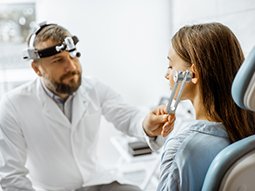There are usually four parathyroid glands that sit behind the thyroid in the neck. These glands regulate the levels of calcium in the body. When the parathyroid glands produce too much hormone, it can lead to problems such as kidney stones, osteoporosis, mood changes, bone pain, and abdominal discomfort. Elevated parathyroid hormone is called hyperparathyroidism and can be caused by:
- Primary hyperparathyroidism – a benign tumor of the parathyroid gland may be producing too much parathyroid hormone
- Secondary hyperparathyroidism – a condition such as kidney failure can result in elevated parathyroid hormone levels in the blood
- Tertiary hyperparathyroidism – after correcting kidney failure, the parathyroid glands can continue to produce too much hormone
- Parathyroid cancer – in rare situations, cancer can form within the parathyroid glands
Your doctor will ask for a complete medical history and will perform a thorough physical examination. Different diagnostic studies may be ordered, including imaging studies, lab tests, and detailed physical examinations. These may include:
- Blood tests: Your doctor may test for abnormal levels of parathyroid hormone and calcium in your blood
- Ultrasonography: Ultrasound uses sound waves that bounce off the body. The computer then interprets those images to create a picture. From the picture, your doctor can see if there is a mass in the neck that looks like an enlarged parathyroid gland
- Sestamibi scan: A study where you have a dye injected into the blood stream that is taken up by the overactive parathyroid gland. Images help to visualize the gland right after the dye is injected, and additional images are taken after a few hours
- SPECT: Images after a dye is injected can be fused with a CT scan in order to help localize the abnormal glands
- 4D CT: A special CT scan can assist with localizing the abnormal glands
Hyperparathyroidism is usually treated by surgical excision of the overactive parathyroid glands.
Our providers

Expert otolaryngology care
Getting the care you need starts with seeing one of our otolaryngologists.









